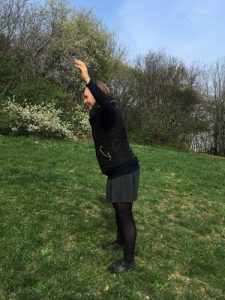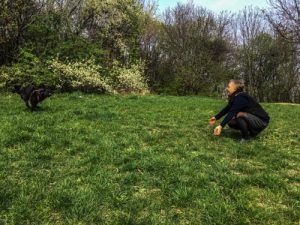Let’s recap: I was walking my dog off leash and talking on the phone. She walked onto a street. I shouted at her to come back, in response she lied down in the middle of the street. Not good. But why? The answer is of course: body language. Let’s have a look.
The human side: what was I doing?
I was standing tall, probably with my arms outstretched to some degree, leaning forward somewhat, using a loud, unpleasant tone of voice. Dogs can learn the meaning of verbal commands, but they’re hard-wired to respond to body language and it’s hard for them to overcome it.
My words meant: come back. My body and tone of voice meant: stay away. For us it is natural to interact face-to-face but dogs – given a choice – approach each other from an angle1. My body language at that moment was probably universally threatening but we, humans, are less sensitive to it as we primarily rely on speech.
Have a look at how I could have improved the situation:
This is what I probably looked like – I was facing her, this shows me from the side so that you can see how I was leaning forward2:

Improvement 1 – hands by my side, not leaning forward anymore:

Improvement 2 – standing sideways:

Improvement 3 – squatting:


The canine side: what was Leus doing?
She stopped when I called her and turned towards me, then she lied down even though I told her to come back. Why would she do that?!
First and foremost, we must throw out of the window the misconception that dogs do things to spite us. Then we can proceed to the actual explanation.
We already established that my body language was threatening – the message “I’m scary” that my body was sending was stronger than the verbal message “come here”. Leus lied down in an attempt to appease me and avoid conflict.
Calming signals
This brings us to the so-called calming signals – a term developed by the Norwegian trainer Turid Rugaas3. She made three important observations that changed the dog training world forever:
- Dogs have a rich body language that they actively use to prevent conflicts.
- They primarily learn this language from other dogs but humans help them with this process.
- Some of the body language can be used by humans too.
Lying down, as Leus did, is one of these calming signals. These are the main signals that Turid Rugaas describes in her book:
- turning the head away/looking away
- “softening” the eyes (kind of like squinting or slowly blinking)
- tongue flicks (the tongue comes out and touches the muzzle or the tip of the nose quickly)
- longer licks around the muzzle
- sitting down
- moving slowly
- moving in a curve/curving
- stopping
- lying down
- sniffing
- yawning
- turning away
- play bow
- peeing
- splitting (dividing other dogs)
- tail wagging
Some of these behaviours can also signal distress: if you are on a crowded bus or in a vet’s waiting room you might see a lot of dogs that are panting, yawning or licking themselves. Obviously, these are just fragments of the body language – dogs can also yawn when they’re sleepy, pant when they are thirsty or wag their tail when they are happy. It is important to evaluate these signals in the context of the given situation. But please, stop shouting at your dog already.
- If you’re interested in exploring this topic you must read Patricia McConnell’s The other end of the leash
- This is obviously an exaggerated pose, dogs can react to much more subtle body language.
- Check out her book On Talking Terms with Dogs: Calming Signals for a more in-depth exploration of this topic.

